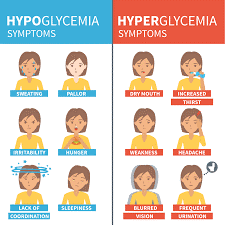A nurse is caring for a school-age child who is taking valproic acid. The nurse should expect the provider to order which of the following diagnostic tests?
Chest x-ray
Serum liver enzyme levels
ABGS
Urine culture and sensitivity
The Correct Answer is B
A. Chest x-ray is not correct because it is not related to valproic acid therapy or its adverse effects.
B. Serum liver enzyme levels is correct because valproic acid can cause hepatotoxicity and liver function tests should be monitored regularly.
C. ABGS is not correct because it is not indicated for valproic acid therapy or its adverse effects.
D. Urine culture and sensitivity is not correct because it is not related to valproic acid therapy or its adverse effects.
Nursing Test Bank
Naxlex Comprehensive Predictor Exams
Related Questions
Correct Answer is A
Explanation
A. Irritability: Correct. Irritability is one of the signs of hypoglycemia, which occurs when blood glucose levels fall below 70 mg/dL (3.9 mmol/L). Other signs include shakiness, sweating, hunger, headache, confusion, and blurred vision.
B. Increased urination: Incorrect. Increased urination is one of the signs of hyperglycemia, which occurs when blood glucose levels rise above 180 mg/dL (10 mmol/L). Other signs include thirst, dry mouth, fatigue, nausea, and fruity breath odor.
C. Vomiting: Incorrect. Vomiting is not a specific sign of hypoglycemia or hyperglycemia, but it can occur as a complication of either condition if left untreated or poorly managed.
D.Facial flushing: Incorrect. Facial flushing is not a sign of hypoglycemia or hyperglycemia, but it can occur as a side effect of some medications used to treat diabetes, such as niacin or rosiglitazone.

Correct Answer is C
Explanation
Choice A reason:
"You should administer the medication at bedtime." This statement is incorrect option. Administering methylphenidate at bedtime is not appropriate because it is a stimulant medication, and taking it in the evening could interfere with the child's ability to fall asleep and disrupt their sleep pattern.
"Your child should avoid foods containing tyramine. “This statement is incorrect option. Tyramine is not a concern with methylphenidate. Tyramine is associated with certain antidepressant medications, such as MAO inhibitors. Methylphenidate is not a MAO inhibitor, so there is no need for the child to avoid tyramine-containing foods.
Option C: "You should administer the medication after breakfast." This is the correct option. Administering methylphenidate after breakfast is a common practice because it allows the child to benefit from the medication during school hours when improved attention and focus are needed the most.
"Your child should avoid excess sodium intake." This statement is an incorrect option. Excess sodium intake is not directly related to methylphenidate use. However, it is generally a good idea for anyone, including children, to have a balanced and healthy diet, which may include monitoring sodium intake. But it is not specifically tied to the administration of methylphenidate.
Whether you are a student looking to ace your exams or a practicing nurse seeking to enhance your expertise , our nursing education contents will empower you with the confidence and competence to make a difference in the lives of patients and become a respected leader in the healthcare field.
Visit Naxlex, invest in your future and unlock endless possibilities with our unparalleled nursing education contents today
Report Wrong Answer on the Current Question
Do you disagree with the answer? If yes, what is your expected answer? Explain.
Kindly be descriptive with the issue you are facing.
